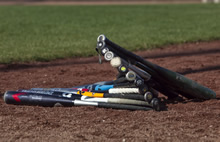Published February 25, 2011 in Baseball Prospectus.
For the first seven seasons at Coors Field, there were 3.20 home runs hit per game compared to 1.93 per Rockies away game. Beginning in 2002, the Colorado Rockies began to store their baseballs in a humidor at a constant 50 percent relative humidity and 70° F, as opposed to the more typical 30 percent humidity in Denver. During the period from 2002-2010 the Coors ratio decreased to 2.39, a reduction of 25 percent, while the away game ratio stayed constant at 1.86. Is it plausible that the reduction in home runs can be attributed to the humidor? The primary goal of this article is to answer that question. Be sure to read the comments, since near the bottom I give my "best and final" numbers for both Coors Field in mile-high Denver, Colorado and Chase Field in Phoenix, Arizona, where the typical relative humidity is around 20 percent. More...
Published January 18, 2010 at BaseballAnalysts.com

The game of baseball as played today at the amateur level is very different from the game I played growing up in Rumford, Maine in the early 1960s. In my youth, wood bats ruled. Nowadays, almost no one outside the professional level uses wood bats, which have largely been replaced by hollow metal (usually aluminum) or composite bats. The original reason for switching to aluminum bats was purely economic, since aluminum bats don't break. However, in the nearly 40 years since they were first introduced, they have evolved into superb hitting instruments that, left unregulated, can significantly outperform wood bats. Indeed, they have the potential of upsetting the delicate balance between pitcher and batter that is at the heart of the game itself. This state of affairs has led various governing agencies (NCAA, Amateur Softball Association, etc.) to impose regulations that limit the performance of nonwood bats. The primary focus of this article is on the techniques used to measure and compare the performance of bats.
This topic has a high degree of current interest because of the new bat performance standards adopted by the NCAA starting in 2011. The same standards will be adopted by the National Federation of High Schools starting in 2012 (and in 2011 in California). More...
See NCAA Baseball Bat Standards and 2011 NCAA Baseball Bat Standards for more information about the NCAA.




